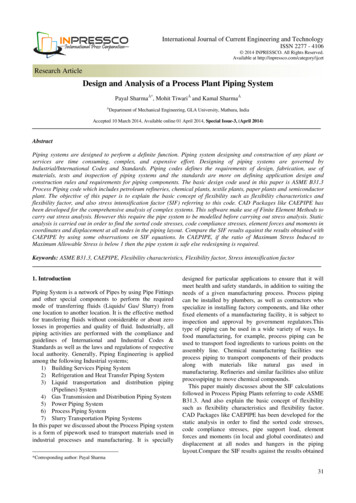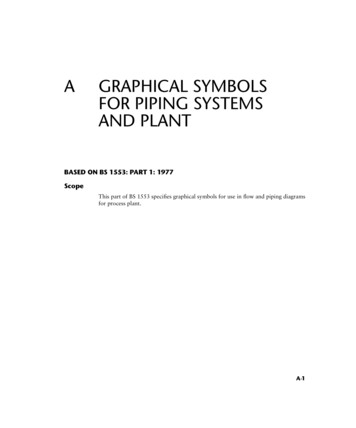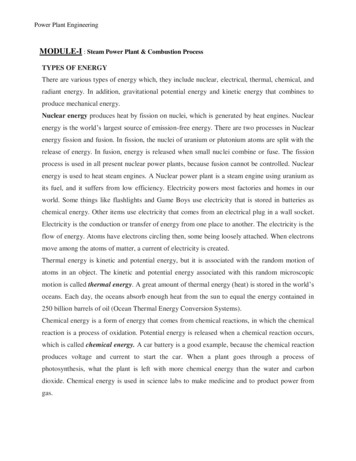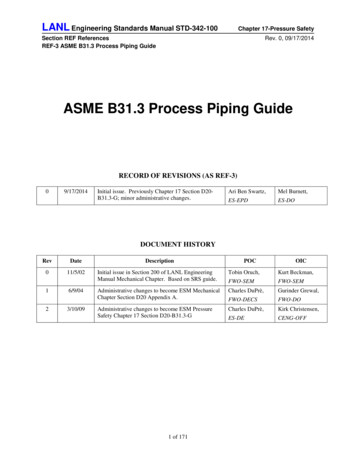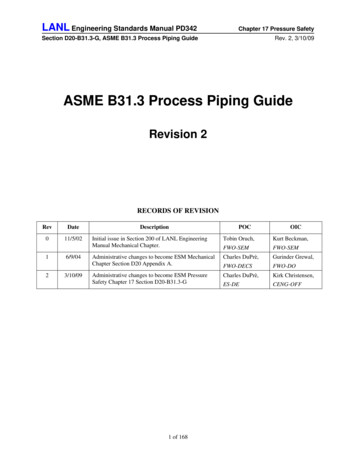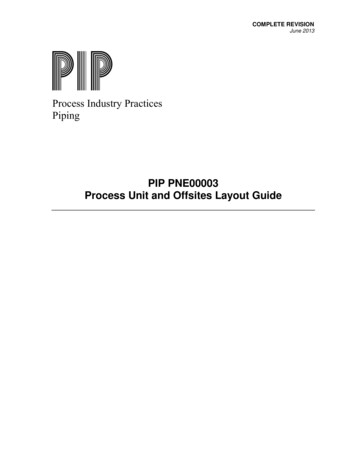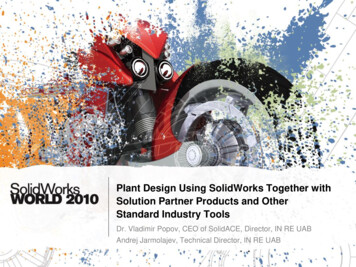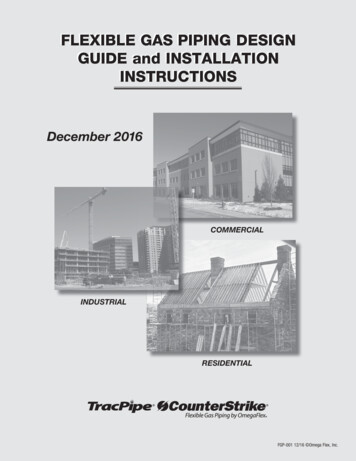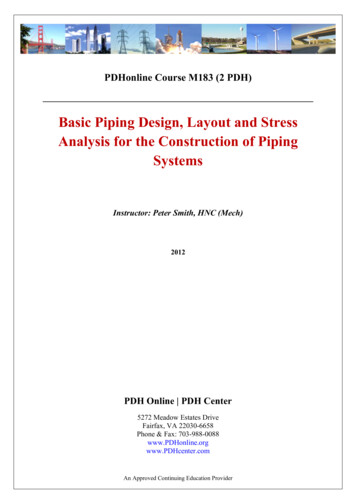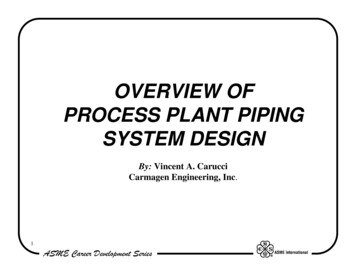
Transcription
OVERVIEW OFPROCESS PLANT PIPINGSYSTEM DESIGNBy: Vincent A. CarucciCarmagen Engineering, Inc.1
Piping SystemPiping system: conveys fluid betweenlocationsPiping system includes: Pipe Fittings (e.g. elbows, reducers, branchconnections, etc.) Flanges, gaskets, bolting Valves Pipe supports2
ASME B31.3 Provides requirements for:– Design– Materials– Fabrication– Erection– Inspection– Testing For process plants including––––3Petroleum refineriesChemical plantsPharmaceutical plantsTextile plants– Paper plants– Semiconductorplants– Cryogenic plants
Scope of ASME B31.3 Piping and piping components, all fluidservices:– Raw, intermediate, and finished chemicals– Petroleum products– Gas, steam, air, and water– Fluidized solids– Refrigerants– Cryogenic fluids Interconnections within packaged equipment Scope exclusions specified4
Strength 5Yield and Tensile StrengthCreep StrengthFatigue StrengthAlloy ContentMaterial Grain sizeSteel Production Process
Stress - Strain DiagramBSACE6
Corrosion Resistance Deterioration of metal by chemical orelectrochemical action Most important factor to consider Corrosion allowanceadded thickness Alloying increases corrosion resistance7
Piping System CorrosionGeneral orUniformCorrosionUniform metal loss. May be combined with erosion ifhigh-velocity fluids, or moving fluids containingabrasives.PittingCorrosionLocalized metal loss randomly located on materialsurface. Occurs most often in stagnant areas or areas oflow-flow velocity.GalvanicCorrosionOccurs when two dissimilar metals contact each other incorrosive electrolytic environment. Anodic metal developsdeep pits or grooves as current flows from it to cathodicmetal.Crevice Corrosion Localized corrosion similar to pitting. Occurs at placessuch as gaskets, lap joints, and bolts where creviceexists.8ConcentrationCell CorrosionOccurs when different concentration of either a corrosivefluid or dissolved oxygen contacts areas of same metal.Usually associated with stagnant fluid.GraphiticCorrosionOccurs in cast iron exposed to salt water or weak acids.Reduces iron in cast iron, and leaves graphite in place.Result is extremely soft material with no metal loss.
Material Toughness Energy necessary to initiate andpropagate a crack Decreases as temperature decreases Factors affecting fracture toughnessinclude:– Chemical composition or alloying elements– Heat treatment– Grain size9
Fabricability Ease of construction Material must be weldable Common shapes and forms include:– Seamless pipe– Plate welded pipe– Wrought or forged elbows, tees, reducers,crosses– Forged flanges, couplings, valves– Cast valves10
Availability and Cost Consider economics Compare acceptable options based on:– Availability– Relative cost11
Pipe Fittings Produce change in geometry––––12Modify flow directionBring pipes togetherAlter pipe diameterTerminate pipe
Elbow and Return90 45 180 Return13Figure 4.1
TeeReducing Outlet TeeCross TeeFigure 4.214
ReducerConcentricEccentricFigure 4.315
Welding Outlet Fitting16Figure 4.4
CapFigure 4.517
Lap-joint Stub EndNote square cornerRREnlarged Sectionof Lap18Figure 4.6
Typical Flange AssemblyFlangeBoltingGasket19Figure 4.7
Types of FlangeAttachment and FacingFlange Attachment TypesFlange Facing TypesThreaded FlangesFlat FacedSocket-Welded FlangesBlind FlangesRaised FaceSlip-On FlangesLapped FlangesRing JointWeld Neck Flanges20Table 4.1
Flange Facing Types21Figure 4.8
Gaskets Resilient materialInserted between flangesCompressed by bolts to create sealCommonly used types– Sheet– Spiral wound– Solid metal ring22
Flange Rating Class Based on ASME B16.5 Acceptable pressure/temperaturecombinations Seven classes (150, 300, 400, 600, 900,1,500, 2,500) Flange strength increases with classnumber Material and design temperaturecombinations without pressure indicatednot acceptable23
Material Specification List24Table 4.2
Pressure - Temperature RatingsMaterialGroup No.ClassesTemp., F-20 to 10485450320215Table 70940885805785755710675650600505345
Sample Problem 1Flange RatingNew piping system to be installed atexisting plant.Determine required flange class. Pipe Material: Design Temperature: Design Pressure:261 1 Cr 1 Mo42700 F500 psig
Sample Problem 1 Solution Determine Material Group Number (Fig. 4.2)Group Number 1.9 Find allowable design pressure atintersection of design temperature and GroupNo. Check Class 150.– Allowable pressure 110 psig design pressure– Move to next higher class and repeat steps For Class 300, allowable pressure 570 psig Required flange Class: 30027
Valves Functions– Block flow– Throttle flow– Prevent flow reversal28
Full Port Gate 19.20.21.22.29Handwheel NutHandwheelStem NutYokeYoke BoltingStemGland FlangeGlandGland Bolts orGland Eye-bolts and nutsGland Lug Bolts and NutsStem PackingPlugLantern RingBackseat BushingBonnetBonnet GasketBonnet Bolts and NutsGateSeat RingBodyOne-Piece Gland (Alternate)Valve PortFigure 5.1
Globe Valve 30Most economic for throttling flowCan be hand-controlledProvides “tight” shutoffNot suitable for scraping or roddingToo costly for on/off block operations
Check Valve Prevents flow reversalDoes not completely shut off reverse flowAvailable in all sizes, ratings, materialsValve type selection determined by– Size limitations– Cost– Availability– Service31
Swing Check ure 5.2
Ball Check Valve33Figure 5.3
Lift Check ValveSeatRingPistonFlowDirection34Figure 5.4
Wafer Check Valve35Figure 5.5
Ball ValveNo.1234567891011121314151617181936Part NamesBodyBody CapBallBody Seal GasketSeatStemGland FlangeStem PackingGland FollowerThrust BearingThrust WasherIndicator StopSnap RingGland BoltStem BearingBody Stud Bolt & NutsGland CoverGland Cover BoltsHandleFigure 5.6
Plug ValveWedgeMolded-In Resilient SealSealing Slip37Figure 5.7
Valve Selection ProcessGeneral procedure for valve selection.1. Identify design information includingpressure and temperature, valve function,material, etc.2. Identify potentially appropriate valvetypes and components based onapplication and function(i.e., block, throttle, or reverse flowprevention).38
Valve Selection Process,cont’d3. Determine valve application requirements(i.e., design or service limitations).4. Finalize valve selection. Check factors toconsider if two or more valves aresuitable.5. Provide full technical descriptionspecifying type, material, flange rating,etc.39
Exercise 1 - DetermineRequired Flange Rating Pipe:1 1 Cr 1 Mo42 Flanges: Design Temperature: Design Pressure:A-182 Gr. F11900 F375 psig40
Exercise 1 - Solution1. Identify material specification of flangeA-182 Gr, F112. Determine Material Group No. (Table 4.2)Group 1.93. Determine class using Table 4.3 with designtemperature and Material Group No.– The lowest Class for design pressure of 375psig is Class 300.– Class 300 has 450 psig maximum pressureat 900 F41
Design Conditions General– Normal operating conditions– Design conditions Design pressure and temperature– Identify connected equipment and associateddesign conditions– Consider contingent conditions– Consider flow direction– Verify conditions with process engineer42
Loading ConditionsPrincipal pipe load types Sustained loads– Act on system all or most of time– Consist of pressure and total weight load Thermal expansion loads– Caused by thermal displacements– Result from restrained movement Occasional loads43– Act for short portion of operating time– Seismic and/or dynamic loading
Stresses Produced ByInternal PressureSlScPt44Sl Longitudinal StressSc Circumferential (Hoop) Stresst Wall ThicknessP Internal PressureFigure 6.1
Stress Categorization Primary Stresses– Direct– Shear– Bending Secondary stresses– Act across pipe wall thickness– Cause local yielding and minor distortions– Not a source of direct failure45
Stress Categorization, cont’d Peak stresses– More localized– Rapidly decrease within short distance oforigin– Occur where stress concentrations andfatigue failure might occur– Significance equivalent to secondary stresses– Do not cause significant distortion46
Allowable StressesFunction of– Material properties– Temperature– Safety factorsEstablished to avoid:– General collapse or excessive distortion fromsustained loads– Localized fatigue failure from thermalexpansion loads– Collapse or distortion from occasional loads47
B31.3 AllowableStresses in TensionBasic Allowable Stress S, ksi. At Metal Temperature, F.MaterialSpec. No/Grade10020030040050060070080090012001300 14001500Carbon SteelA 106B20.020.020.020.018.917.316.510.86.52.51.0C - ½MoA 335P118.318.317.516.916.315.715.113.512.74.2.41¼ - ½MoA 218Cr - 8Ni pipeA 312TP304 .31.416Cr - 12Ni-2MopipeA 312TP316 2.31.3Table 6.1481000 1100
Pipe Thickness RequiredFor Internal Pressure PDt 2 (SE PY )P Design pressure, psigD Pipe outside diameter, in.S Allowable stress in tension, psiE Longitudinal-joint quality factorY Wall thickness correction factor 49t m t CAt nom tm0.875
Spec.No.Class (or Type)DescriptionEjCarbon SteelAPI5L.Seamless pipeElectric resistance welded pipeElectric fusion welded pipe, double butt, straight orspiral seamFurnace butt welded1.000.850.95A 53Type SType EType FSeamless pipeElectric resistance welded pipeFurnace butt welded pipe1.000.850.60A 106.Seamless pipe1.00Low and Intermediate Alloy SteelA 333.Seamless pipeElectric resistance welded pipe1.000.85A 335.Seamless pipe1.00Stainless SteelA 312.Seamless pipeElectric fusion welded pipe, double butt seamElectric fusion welded pipe, single butt seam1.000.850.80A 3581, 3, 452Electric fusion welded pipe, 100% radiographedElectric fusion welded pipe, spot radiographedElectric fusion welded pipe, double butt seam1.000.900.85Nickel and Nickel Alloy50B 161.Seamless pipe and tube1.00B 514.Welded pipe0.80B 675AllWelded pipe0.80Table 6.2
Temperature, FMaterials900 & lower9501000105011001150 & 40.4Cast iron0.0.Table 6.351
Curved and Mitered Pipe Curved pipe– Elbows or bends– Same thickness as straight pipe Mitered bend– Straight pipe sections welded together– Often used in large diameter pipe– May require larger thickness Function of number of welds, conditions, size52
Sample Problem 2 Determine Pipe Wall ThicknessDesign temperature: 650 FDesign pressure: 1,380 psig.Pipe outside diameter: 14 in.Material: ASTM A335, Gr. P11 ( 1 14 Cr 12 Mo ),seamlessCorrosion allowance: 0.0625 in.53
Sample Problem 2 - SolutionPDt 2(SE PY )1,380 14t 2[(16,200 1) (1,380 0.4 )]t 0.577 in.54
Sample Problem 2 Solution, cont’dtm t c 0.577 0.0625 0.6395 in.0.6395t nom 0.731 in.0.87555
Welded Branch ConnectionDbTbReinforcementZone .cthMillTol.d1A2A2d2d2βPipe C56ReinforcementZone LimitsFigure 6.2
Reinforcement AreaDb 2(Tb c)d1 sin βd1 Effective length removed from run pipe, in.Db Branch outside diameter, in.Tb Minimum branch thickness, in.c Corrosion allowance, in.β Acute angle between branch and header57
Required Reinforcement AreaRequired reinforcement area, A1:A 1 t h d1(2 sin β)Where: th Minimum required headerthickness, in.58
Reinforcement Pad Provides additional reinforcement Usually more economical than increasingwall thickness Selection variables– Material– Outside diameter– Wall thicknessæ (Dp Db ) öTrA 4 ççè sin β59
Sample Problem 3 Pipe material: Seamless, A 106/Gr. B forbranch and header, S 16,500 psi Design conditions: 550 psig @ 700 F c 0.0625 in. Mill tolerance: 12.5%60
Sample Problem 3, cont’d Nominal PipeThicknesses:Header: 0.562 in.Branch: 0.375 in. Required PipeThicknesses:Header: 0.395 in.Branch: 0.263 in. Branch connection at 90 angle61
Sample Problem 3 - SolutionDb 2(Tb c)d1 sin β16 2 (0.375 0.875 0.0625 )d1 15.469 in.sin 90 A1 thd1(2 sinβ)A1 0.395 15.469 (2 sin90 ) 6.11 in.262
Sample Problem 3 Solution, cont’d Calculate excess area available in header, A2.A 2 (2d2 d1)(Th th c )d2 d1 15.469 in. Dh 24 in.A2 (2 15.469 - 15.469) (0.875 0.562 0.395 - 0.0625)A2 0.53 in.263
Sample Problem 3 Solution, cont’d Calculate excess area available in branch, A3.2L 4 (Tb tb c )A3 sinβL 4 2.5 (0.875 0.375 0.0625 ) 0.664 in.A3 642 0.664 (0.875 0.375 0.263 0.0625 ) 0.003 in.2sin 90
Sample Problem 3 Solution, cont’d Calculate other excess area available, A4.A4 0. Total Available Area:AT A2 A3 A4AT 0.53 0.003 0 0.533 in.2 availablereinforcement.AT A1 Pad needed65
Sample Problem 3 Solution, cont’d Reinforcement pad: A106, Gr. B, 0.562 in. thick Recalculate Available ReinforcementL41 2.5 (Th - c) 2.5 (0.875 0.562 - 0.0625) 1.073 in.L42 2.5 (Tb - c) Tr 2.5 (0.875 0.375 - 0.0625) 0.562 (0.875) 1.16 in66
Sample Problem 3 Solution, cont’dTherefore, L4 1.073 in.2L 4 (Tb t b c)A3 sin βA3 2 1.073 (0.875 0.375 0.263 0.0625 )sin90 oA 3 0.005 in.2 (vs. the 0.003 in.2 previously ca
PROCESS PLANT PIPING SYSTEM DESIGN By: Vincent A. Carucci Carmagen Engineering, Inc. 2 Piping System Piping system: conveys fluid between locations Piping system includes: Pipe Fittings (e.g. elbows, reducers, branch connections, etc.) Flanges, gaskets, bolting Valves Pipe supports. 3 ASME B31.3 –Design – Materials – Fabrication – Petroleum refineries – Chemical .File Size: 488KBPage Count: 133
